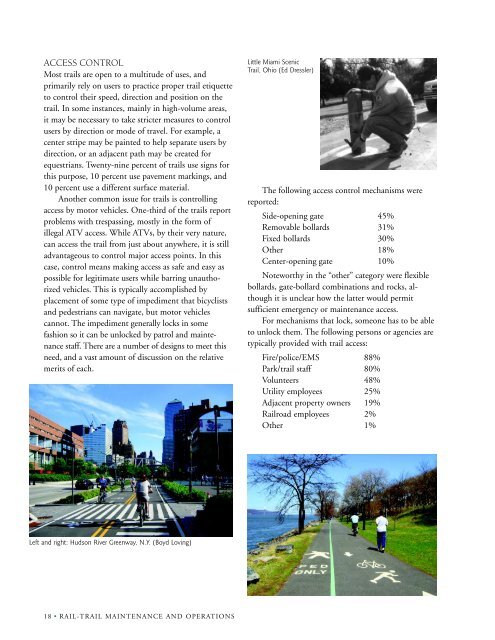Trail Maintenance and Operation - Rails-to-Trails Conservancy
Trail Maintenance and Operation - Rails-to-Trails Conservancy
Trail Maintenance and Operation - Rails-to-Trails Conservancy
You also want an ePaper? Increase the reach of your titles
YUMPU automatically turns print PDFs into web optimized ePapers that Google loves.
ACCESS CONTROL<br />
Most trails are open <strong>to</strong> a multitude of uses, <strong>and</strong><br />
primarily rely on users <strong>to</strong> practice proper trail etiquette<br />
<strong>to</strong> control their speed, direction <strong>and</strong> position on the<br />
trail. In some instances, mainly in high-volume areas,<br />
it may be necessary <strong>to</strong> take stricter measures <strong>to</strong> control<br />
users by direction or mode of travel. For example, a<br />
center stripe may be painted <strong>to</strong> help separate users by<br />
direction, or an adjacent path may be created for<br />
equestrians. Twenty-nine percent of trails use signs for<br />
this purpose, 10 percent use pavement markings, <strong>and</strong><br />
10 percent use a different surface material.<br />
Another common issue for trails is controlling<br />
access by mo<strong>to</strong>r vehicles. One-third of the trails report<br />
problems with trespassing, mostly in the form of<br />
illegal ATV access. While ATVs, by their very nature,<br />
can access the trail from just about anywhere, it is still<br />
advantageous <strong>to</strong> control major access points. In this<br />
case, control means making access as safe <strong>and</strong> easy as<br />
possible for legitimate users while barring unauthorized<br />
vehicles. This is typically accomplished by<br />
placement of some type of impediment that bicyclists<br />
<strong>and</strong> pedestrians can navigate, but mo<strong>to</strong>r vehicles<br />
cannot. The impediment generally locks in some<br />
fashion so it can be unlocked by patrol <strong>and</strong> maintenance<br />
staff. There are a number of designs <strong>to</strong> meet this<br />
need, <strong>and</strong> a vast amount of discussion on the relative<br />
merits of each.<br />
Little Miami Scenic<br />
<strong>Trail</strong>, Ohio (Ed Dressler)<br />
The following access control mechanisms were<br />
reported:<br />
Side-opening gate 45%<br />
Removable bollards 31%<br />
Fixed bollards 30%<br />
Other 18%<br />
Center-opening gate 10%<br />
Noteworthy in the “other” category were flexible<br />
bollards, gate-bollard combinations <strong>and</strong> rocks, although<br />
it is unclear how the latter would permit<br />
sufficient emergency or maintenance access.<br />
For mechanisms that lock, someone has <strong>to</strong> be able<br />
<strong>to</strong> unlock them. The following persons or agencies are<br />
typically provided with trail access:<br />
Fire/police/EMS 88%<br />
Park/trail staff 80%<br />
Volunteers 48%<br />
Utility employees 25%<br />
Adjacent property owners 19%<br />
Railroad employees 2%<br />
Other 1%<br />
Left <strong>and</strong> right: Hudson River Greenway, N.Y. (Boyd Loving)<br />
18 • RAIL-TRAIL MAINTENANCE AND OPERATIONS







